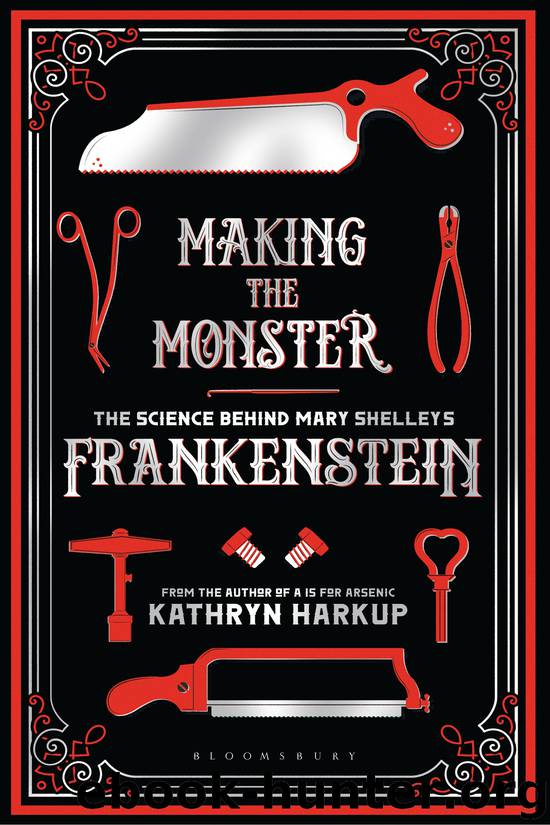Making the Monster by Kathryn Harkup

Author:Kathryn Harkup
Language: eng
Format: epub
Publisher: Bloomsbury Publishing
Working conditions for Victor must have been nearly unbearable and it is no surprise that Mary glossed over the gory details. Victor’s own description of the work as ‘filthy’ must be something of an understatement. Victor worked through the heat of the summer months. His lab was described as a simple room at the top of his lodgings, ‘my workshop of filthy creation’, hardly the ideal location for sophisticated and delicate anatomical work. During the drying process plenty of space was required for stretching out samples; at the university in Dublin they used the roof for lack of a better alternative. Those who worked in preserving specimens from the dissection rooms located their macerators and drying boards in rooms as far away from others as possible – some even resorting to sheds. This gave them more space in which to work but it also kept the worst of the smell away.
It wasn’t only humans who noticed the smell. Several anatomists in the eighteenth century complained of problems with rats. Mary had Victor living in lodgings and it would have been difficult to keep the smell and vermin from giving away what he was up to. And this wasn’t even the worst of his problems.
Working in a tiny room lit only by candles would not have been easy. It was also considerably hazardous: naked flames and alcohol vapours do not mix well. Apart from the very real risk of fire, Victor would have also had to cope with the headaches frequently complained of by those who worked in the preparation rooms.
Anatomical curators in the nineteenth century were described as prematurely aged, emaciated and plagued with fits of coughing. It wasn’t just the alcohol fumes impairing their performance: the chemicals they used did direct damage to curators’ health. Experienced curators warned against letting novices try out methods involving mercury salts due to their associated dangers. Mercury salts are highly toxic; elemental mercury, used to distend vessels, will vaporise and end up in the curator’s lungs; and turpentine can cause lung and skin irritation. Yet even these are mild inconveniences compared with the hazards associated with the anatomical material itself.
The most serious risk to Victor’s health would have been infection. The slightest slip of the knife or an open cut on the hand could very easily have introduced bacteria from a cadaver into Victor’s body. In a time before antibiotics this would very likely be fatal. Several young medical students died because of a little carelessness in the dissecting room. In April 1778, Erasmus Darwin’s own son, Charles – who had followed in his father’s footsteps and was studying medicine in Edinburgh – cut himself when dissecting the body of a child. He fell ill from the cut almost immediately, complaining of severe headaches. The following day he was in convulsions and haemorrhaging. He died on 15 May, just days before his 20th birthday.
It is extremely unlikely that Mary ever had first-hand experience of dissection or preservation facilities, but she may have heard
Download
This site does not store any files on its server. We only index and link to content provided by other sites. Please contact the content providers to delete copyright contents if any and email us, we'll remove relevant links or contents immediately.
4 3 2 1: A Novel by Paul Auster(12283)
The handmaid's tale by Margaret Atwood(7679)
Giovanni's Room by James Baldwin(7191)
Asking the Right Questions: A Guide to Critical Thinking by M. Neil Browne & Stuart M. Keeley(5635)
Big Magic: Creative Living Beyond Fear by Elizabeth Gilbert(5610)
Ego Is the Enemy by Ryan Holiday(5294)
The Body: A Guide for Occupants by Bill Bryson(4974)
On Writing A Memoir of the Craft by Stephen King(4863)
Ken Follett - World without end by Ken Follett(4645)
Adulting by Kelly Williams Brown(4487)
Bluets by Maggie Nelson(4473)
Eat That Frog! by Brian Tracy(4435)
Guilty Pleasures by Laurell K Hamilton(4360)
The Poetry of Pablo Neruda by Pablo Neruda(4039)
Alive: The Story of the Andes Survivors by Piers Paul Read(3968)
White Noise - A Novel by Don DeLillo(3954)
Fingerprints of the Gods by Graham Hancock(3942)
The Book of Joy by Dalai Lama(3899)
The Bookshop by Penelope Fitzgerald(3775)
